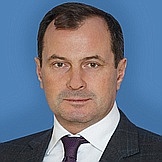Regional flags and emblems


PROFILE
Established 1934 as Udmurt ASSR, since 1991 – the Udmurtian Republic
Capital Izhevsk
The Udmurtian Republic is part of the Volga Federal District
Area 42,100 sq km
Population 1 427 000 (2025)
Ethnic groups
(2020 National Census, %)
Russian – 67,71
Udmurt – 24,13
Tatar – 5,47
Other – 2,69
Administrative divisions (2024)
Municipal districts – 25
City districts – 5
Geography and climate
The Udmurtian Republic is situated in the foothills of the Urals, between the Kama and Vyatka rivers. Configuration of terrain: an undulating plain divided by river valleys and gullies. In the northern part of the republic there is the Upper Kama Upland (altitudes up to 330 m), in the west – poorly drained and partly swampy lowland, and in the south – the Mozhginsk and Sarapul uplands. The distance from north to south is 270 km, from east to west – 180 km.
The Udmurtian Republic borders on the republics of Tatarstan and Bashkortostan, the Perm Territory and the Kirov Region.
There are about 600 large and small rivers, over 2,000 springs, and about 1,900 ponds and reservoirs. The main rivers are: the Kama, Vyatka, Siva, Izh, Toima, Bolhshaya Sarapulka, Malaya Sarapulka, Cheptsa, and Kilmez.
The climate is temperate continental. January temperatures average –14.0°C, July temperatures average 15.7°C. Average precipitation in January is 35 mm; average precipitation in July is 44 mm.
The vegetation is represented by coniferous and mixed forests: spruce, fir, pine, larch, birch, linden, aspen.
The republic is home to the Nechkinsky National Park, which covers 20,752 ha. There you can find numerous animal and plants species which are included in the Red Book of the Udmurtian Republic.
Government
The legislative branch is represented by the State Council of the Udmurtian Republic, which is the permanent, representative and only body of legislative authority in the republic.
The State Council has 60 deputies elected for five years, with 40 of them running in single-mandate constituencies and the other 20 in the single electoral district, where winners are identified in proportion to the number of votes cast for lists of deputies nominated by electoral associations.
The current State Council of the Udmurtian Republic was elected in September 2022. Its term expires in September 2027.
Executive power in the republic is exercised by the Head of the Udmurtian Republic, the Government of the Udmurtian Republuc and some other executive authorities.
The Government of the Udmurtian Republic is the supreme and permanent body of executive authority in the republic.
Head of the Republic of Udmurtia is the republic’s highest-ranking official, who runs the executive branch and determines the structure of the executive agencies in the Republic of Udmurtia. He is elected for a five-year term by the citizens of the Russian Federation who permanently reside in the republic. The term of the incumbent Head of the Republic of Udmurtia expires in September 2027.
Economy and natural resources
The republic’s leading economic sector is industry, which accounts for over 45% of the regional GDP. The most important industrial enterprises belong to the military-industrial sector and manufacture high-technology products which are highly competitive on the global market.
The republic’s enterprises produce equipment for nuclear power stations, space telecommunications systems, various types of weapons and military equipment, communications equipment, electronics, medical devices, oil and gas equipment, metal and plastic articles. The wood processing industry is a significant part of the local economy.
One of the most important industrial developments today is the formation of the Udmurt machine-building cluster. It includes the leading defence plants and universities in the republic.
Agriculture is also important for the development of the Udmurtian Republic. Nowadays, the republic’s needs for the basic food products are met in full. Moreover, local food products are exported to over 60 Russian regions and a number of foreign countries.
Cattle breeding, pig farming and poultry farming are being developed in the republic. Agriculture specialises in the cultivation of forage grain crops, potatoes, open-air and greenhouse cultivation of vegetables, and forage crops.
The most important industrial crop is linen flax. The republic is one of the leading manufacturers of flax fibre and ranks fourth in Russia in flax production.
The most important natural resources are oil, coal, peat, and construction minerals. There are also known deposits of black and brown coal. The largest peat deposits are located in the basins of the Kilmez and the Cheptsa rivers. There are also deposits of limestone, clay, sand and gravel. The annual production of oil in the region is over 10 million tonnes. The total amount of known oil deposits is about 300 million tonnes. 46% of the republic's territory is covered with forests, half of which are coniferous.
The main industrial enterprises
in the Udmurtian Republic are:
— Izhevsk Mechanical Plant – a multifunctional industrial
enterprise producing non-lethal weapons for law enforcement and civil
small arms, electrical tools, packaging equipment, and precision steel
casting;
— Votkinsk Plant – a machine-building complex producing
strategic missiles and short-range missiles;
- Izhneftemash – a machine-building enterprise producing oil field equipment;
- Izhstal – an iron works producing steel, wire, forged and stamped parts, shaped steel profiles, and consumer goods;
- Udmurtneft – field geological exploration, hydrocarbon deposit development and exploitation.
Culture and tourism
The Udmurtian Republic is the birthplace of the great composer Pyotr Tchaikovsky. A hallmark of the republic is the Tchaikovsky house museum in Votkinsk, which attracts about 100,000 visitors every year. The composer’s name was given to a music school in Votkinsk, Izhevsk Public Chamber Choir, and a city garden in Votkinsk. A music festival dedicated to Tchaikovsky is held annually in Udmurtia. There is also a number of large regional music festivals and competitions named after him.
There are 11 professional theatres, and 28 museums in the Udmurtian Republic, Ten Udmurtian museums are included in tourist itineraries of various travel companies.
There are over 570 public libraries in the Udmurtian Republic, including three republican libraries (the National Library of the Udmurtian Republic, the Republican Library for Children and Young People, and the Udmurtian Republican Library for the Blind). Other libraries are located in rural areas.
There are over 400 architectural, historical, and cultural landmarks, including 40 landmarks of federal significance. The Udmurtian Republic has a rich non-material cultural legacy, including its customs, knowledge, skills, and traditions. Applied and decorative folk arts constitute an integral part of the Udmurtian culture, which is a source of inspiration for modern art and is inseparable from life in the republic today.
Agritourism is also developing in this region. Over 150 private farms in rural areas are open to tourists.


